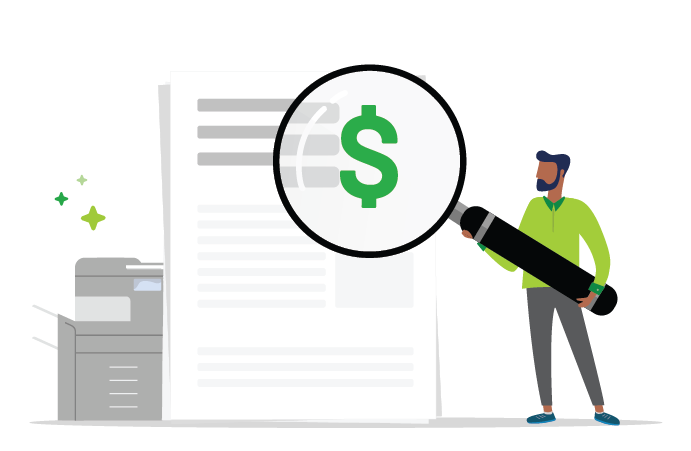Paper may (literally) grow on trees – but that doesn’t mean that printing will be free. Print costs don’t just include the paper itself but the ink that’s printed on them, not to mention what you need to spend on equipment and labor.
So what is the true cost of printing a single page? Let’s break it down.
Understanding the factors that make up your printing cost per page
No matter what line of business you’re in, there’s a good chance that printing is chewing up a good part of your budget each year. In fact, a study by Gartner showed that total print costs make up between 1% and 3% of a company’s overall revenue.
Your print costs will be affected by a number of factors, including:
- Printers. In addition to the purchase or lease price, maintenance and energy costs accumulate over a printer’s lifetime, making each piece of paper costlier than the previous one.
- Paper. The cost of a single page of paper could be anywhere from half a cent to two cents, which might not seem too bad…until you multiply it by an average of 10,000 sheets printed by a single office worker each year.
- Printer consumables. Printers require ink cartridges and toner which might cost somewhere between $5 and $100 to replace.
- Productivity. There are also unseen costs associated with printing, such as labor involved with maintaining the print environment and wasted worker time waiting for issues to be fixed.
Calculating your printing cost per page
Find out the page yield per cartridge
Page yield is the approximate number of pages you can print with a single cartridge. It should be easy to find out, as most manufacturers print it on their website or the side of the cartridge box. Different figures are usually provided for black-and-white and color printing.
Keep in mind that page yield is based on 5% coverage, or about one-third of a page of double-spaced text. If you print pages with a lot of text or images, your actual printing costs are going to be higher.
Work out the cost of each cartridge
The prices of different brands of cartridge can vary significantly – even when they have the exact same page yield. You may need to speak to the accounting team to get this information; otherwise, you can use average retail prices from the manufacturer’s website.
Add in the cost of printer paper
As mentioned, the standard cost of printing can be up to two cents per sheet – but premium or specialty paper is a lot more expensive, perhaps as much as 10 cents a sheet. Because you buy paper in reams, you need to divide the total cost by the number of pieces of paper. This will give you an amount per individual page.
So, what does a piece of paper cost to print, really?
Once you have the page yield, and the costs of cartridges and paper, it’s fairly simple to calculate the cost of printing using this formula:
Cartridge price / page yield + paper cost = cost per page
For example, if you have a cartridge that cost $100 with a page yield of 2,000 pages, and your sheet of paper is 1 cent, then your calculation will look like this:
$100 / 2000 + 0.01 = $0.051 per page (a little over 5 cents)
Pssst… don’t forget the additional printing costs
Now that you know you have the base price of a page, remember all the other expenses that make up the true cost of printing. Your accounting department can provide you with the purchase or lease price of your printers, and details of what you’re spending on things like staples, hole punchers, and office supplies.
Remember, the cost of your equipment should also include the cost of maintenance and your printer’s lifespan. By working out how many pages you print a month, you can get an estimate of how long your printer will last.
Unfortunately, there is no straightforward formula when it comes to the additional costs, but it can be helpful to look at your total spending over a defined period like a year and combine this with your print costs.
Reducing your printing costs
While the costs of printing can quickly add up, a few simple measures will go a long way in making print savings:
- Conduct a print assessment to understand how much you are printing and why – and identify where wastage is happening.
- Develop a printer inventory so you know exactly what devices you have and the supplies you need for different devices.
- Streamline printing with a multifunction device in a centralized location to save the costs of running separate print, scan, and copy machines.
- Put one person in charge of purchasing ink, toner, and paper to avoid wasted supplies and incorrect orders.
- Set your printer defaults to black-and-white, double-sided printing.
- Don’t try to scrimp on cheap ink and toner cartridges – while it might be cheaper upfront, your print quality will suffer, with pages requiring reprinting.
- Engage a managed print service provider to analyze your current print process and determine costs.
- Add print management software like Papercut to take care of many of these decisions for you!
Remember, reducing your printing also helps lessen your environmental impact – which is good news for the trees and GREAT news for your business (and your sustainability goals!)
Discover more about print management, read our helpful print charging article by clicking on the link below.
Click Here

